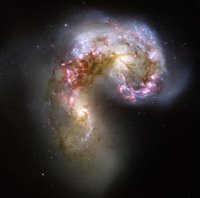Colliding Galaxies Ignite Stellar Nurseries (Amazing Spectacle !!) Saturday, October 21, 2006
 Extracts from "National Geographic News"
Extracts from "National Geographic News"Scientists haven't been able to take their eyes off a nearby stellar collision. This image, snapped by the Hubble Space Telescope and released October 16, is the sharpest yet of the merging Antennae Galaxies.
The spiral galaxies, named for long antenna-like arms that extend far from the galaxies' centers, began colliding only a few hundred million years ago. The pair represents one of the closest galactic collisions to Earth, and one of the youngest known to science.
The reddish-orange blobs to the right and left of the picture's center are the two galactic cores—consisting mostly of old stars crisscrossed by filaments of dust (brown).
What has researchers really excited, though, are the blue star-forming regions, which are surrounded by hot glowing hydrogen gas (pink). Billions of new stars will be formed by the energetic collision, scientists say.
The brightest and most compact star-forming regions are called super star clusters.
By determining the age of clusters in the image, scientists now know that only about 10 percent of super star clusters will last for a substantial amount of time. These collections will most likely go on to form globular clusters—densely packed spheres of stars that orbit a galaxy—similar to globular formations in our home galaxy, the Milky Way.
The rest of the super star clusters will disperse, with the stars born there disappearing into the galaxies' background.
posted by m o g L i e @ 11:32:00 am,
![]()
![]()

